Yue Xing
TRAJECT-Bench:A Trajectory-Aware Benchmark for Evaluating Agentic Tool Use
Oct 06, 2025
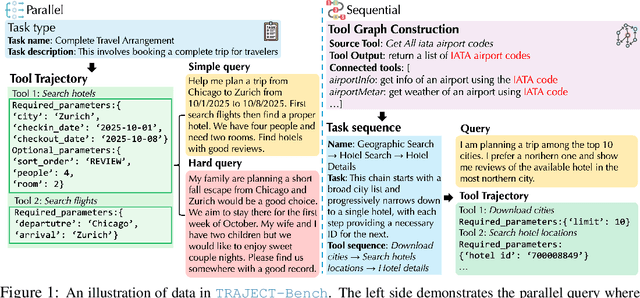


Abstract:Large language model (LLM)-based agents increasingly rely on tool use to complete real-world tasks. While existing works evaluate the LLMs' tool use capability, they largely focus on the final answers yet overlook the detailed tool usage trajectory, i.e., whether tools are selected, parameterized, and ordered correctly. We introduce TRAJECT-Bench, a trajectory-aware benchmark to comprehensively evaluate LLMs' tool use capability through diverse tasks with fine-grained evaluation metrics. TRAJECT-Bench pairs high-fidelity, executable tools across practical domains with tasks grounded in production-style APIs, and synthesizes trajectories that vary in breadth (parallel calls) and depth (interdependent chains). Besides final accuracy, TRAJECT-Bench also reports trajectory-level diagnostics, including tool selection and argument correctness, and dependency/order satisfaction. Analyses reveal failure modes such as similar tool confusion and parameter-blind selection, and scaling behavior with tool diversity and trajectory length where the bottleneck of transiting from short to mid-length trajectories is revealed, offering actionable guidance for LLMs' tool use.
SoK: Machine Unlearning for Large Language Models
Jun 10, 2025

Abstract:Large language model (LLM) unlearning has become a critical topic in machine learning, aiming to eliminate the influence of specific training data or knowledge without retraining the model from scratch. A variety of techniques have been proposed, including Gradient Ascent, model editing, and re-steering hidden representations. While existing surveys often organize these methods by their technical characteristics, such classifications tend to overlook a more fundamental dimension: the underlying intention of unlearning--whether it seeks to truly remove internal knowledge or merely suppress its behavioral effects. In this SoK paper, we propose a new taxonomy based on this intention-oriented perspective. Building on this taxonomy, we make three key contributions. First, we revisit recent findings suggesting that many removal methods may functionally behave like suppression, and explore whether true removal is necessary or achievable. Second, we survey existing evaluation strategies, identify limitations in current metrics and benchmarks, and suggest directions for developing more reliable and intention-aligned evaluations. Third, we highlight practical challenges--such as scalability and support for sequential unlearning--that currently hinder the broader deployment of unlearning methods. In summary, this work offers a comprehensive framework for understanding and advancing unlearning in generative AI, aiming to support future research and guide policy decisions around data removal and privacy.
Structured Memory Mechanisms for Stable Context Representation in Large Language Models
May 28, 2025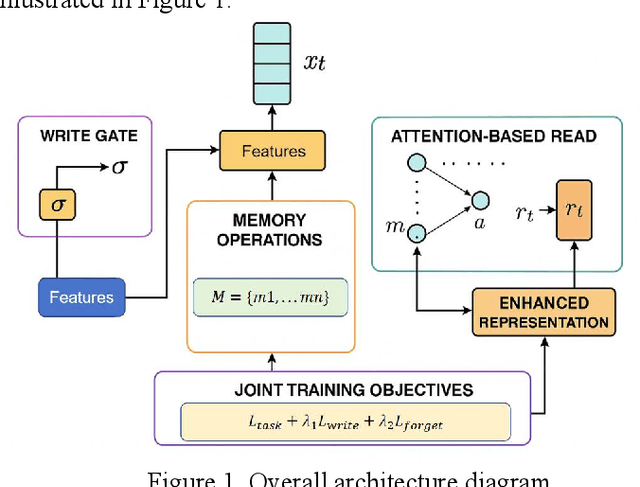

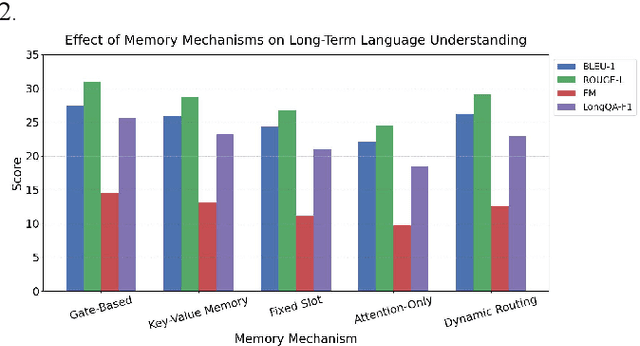
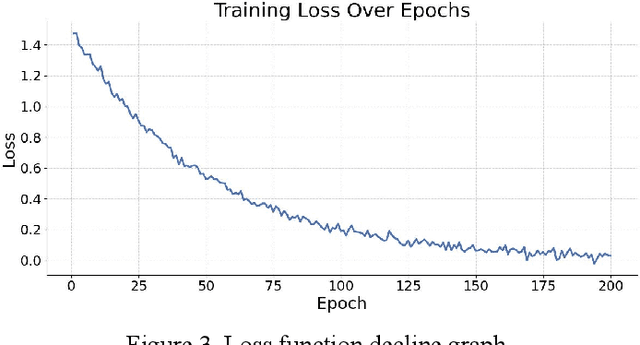
Abstract:This paper addresses the limitations of large language models in understanding long-term context. It proposes a model architecture equipped with a long-term memory mechanism to improve the retention and retrieval of semantic information across paragraphs and dialogue turns. The model integrates explicit memory units, gated writing mechanisms, and attention-based reading modules. A forgetting function is introduced to enable dynamic updates of memory content, enhancing the model's ability to manage historical information. To further improve the effectiveness of memory operations, the study designs a joint training objective. This combines the main task loss with constraints on memory writing and forgetting. It guides the model to learn better memory strategies during task execution. Systematic evaluation across multiple subtasks shows that the model achieves clear advantages in text generation consistency, stability in multi-turn question answering, and accuracy in cross-context reasoning. In particular, the model demonstrates strong semantic retention and contextual coherence in long-text tasks and complex question answering scenarios. It effectively mitigates the context loss and semantic drift problems commonly faced by traditional language models when handling long-term dependencies. The experiments also include analysis of different memory structures, capacity sizes, and control strategies. These results further confirm the critical role of memory mechanisms in language understanding. They demonstrate the feasibility and effectiveness of the proposed approach in both architectural design and performance outcomes.
Modeling Multi-Hop Semantic Paths for Recommendation in Heterogeneous Information Networks
May 09, 2025



Abstract:This study focuses on the problem of path modeling in heterogeneous information networks and proposes a multi-hop path-aware recommendation framework. The method centers on multi-hop paths composed of various types of entities and relations. It models user preferences through three stages: path selection, semantic representation, and attention-based fusion. In the path selection stage, a path filtering mechanism is introduced to remove redundant and noisy information. In the representation learning stage, a sequential modeling structure is used to jointly encode entities and relations, preserving the semantic dependencies within paths. In the fusion stage, an attention mechanism assigns different weights to each path to generate a global user interest representation. Experiments conducted on real-world datasets such as Amazon-Book show that the proposed method significantly outperforms existing recommendation models across multiple evaluation metrics, including HR@10, Recall@10, and Precision@10. The results confirm the effectiveness of multi-hop paths in capturing high-order interaction semantics and demonstrate the expressive modeling capabilities of the framework in heterogeneous recommendation scenarios. This method provides both theoretical and practical value by integrating structural information modeling in heterogeneous networks with recommendation algorithm design. It offers a more expressive and flexible paradigm for learning user preferences in complex data environments.
How to Enhance Downstream Adversarial Robustness (almost) without Touching the Pre-Trained Foundation Model?
Apr 15, 2025Abstract:With the rise of powerful foundation models, a pre-training-fine-tuning paradigm becomes increasingly popular these days: A foundation model is pre-trained using a huge amount of data from various sources, and then the downstream users only need to fine-tune and adapt it to specific downstream tasks. However, due to the high computation complexity of adversarial training, it is not feasible to fine-tune the foundation model to improve its robustness on the downstream task. Observing the above challenge, we want to improve the downstream robustness without updating/accessing the weights in the foundation model. Inspired from existing literature in robustness inheritance (Kim et al., 2020), through theoretical investigation, we identify a close relationship between robust contrastive learning with the adversarial robustness of supervised learning. To further validate and utilize this theoretical insight, we design a simple-yet-effective robust auto-encoder as a data pre-processing method before feeding the data into the foundation model. The proposed approach has zero access to the foundation model when training the robust auto-encoder. Extensive experiments demonstrate the effectiveness of the proposed method in improving the robustness of downstream tasks, verifying the connection between the feature robustness (implied by small adversarial contrastive loss) and the robustness of the downstream task.
A General Framework to Enhance Fine-tuning-based LLM Unlearning
Feb 25, 2025Abstract:Unlearning has been proposed to remove copyrighted and privacy-sensitive data from Large Language Models (LLMs). Existing approaches primarily rely on fine-tuning-based methods, which can be categorized into gradient ascent-based (GA-based) and suppression-based methods. However, they often degrade model utility (the ability to respond to normal prompts). In this work, we aim to develop a general framework that enhances the utility of fine-tuning-based unlearning methods. To achieve this goal, we first investigate the common property between GA-based and suppression-based methods. We unveil that GA-based methods unlearn by distinguishing the target data (i.e., the data to be removed) and suppressing related generations, which is essentially the same strategy employed by suppression-based methods. Inspired by this finding, we introduce Gated Representation UNlearning (GRUN) which has two components: a soft gate function for distinguishing target data and a suppression module using Representation Fine-tuning (ReFT) to adjust representations rather than model parameters. Experiments show that GRUN significantly improves the unlearning and utility. Meanwhile, it is general for fine-tuning-based methods, efficient and promising for sequential unlearning.
Towards Context-Robust LLMs: A Gated Representation Fine-tuning Approach
Feb 22, 2025Abstract:Large Language Models (LLMs) enhanced with external contexts, such as through retrieval-augmented generation (RAG), often face challenges in handling imperfect evidence. They tend to over-rely on external knowledge, making them vulnerable to misleading and unhelpful contexts. To address this, we propose the concept of context-robust LLMs, which can effectively balance internal knowledge with external context, similar to human cognitive processes. Specifically, context-robust LLMs should rely on external context only when lacking internal knowledge, identify contradictions between internal and external knowledge, and disregard unhelpful contexts. To achieve this goal, we introduce Grft, a lightweight and plug-and-play gated representation fine-tuning approach. Grft consists of two key components: a gating mechanism to detect and filter problematic inputs, and low-rank representation adapters to adjust hidden representations. By training a lightweight intervention function with only 0.0004\% of model size on fewer than 200 examples, Grft can effectively adapt LLMs towards context-robust behaviors.
Multi-Faceted Studies on Data Poisoning can Advance LLM Development
Feb 20, 2025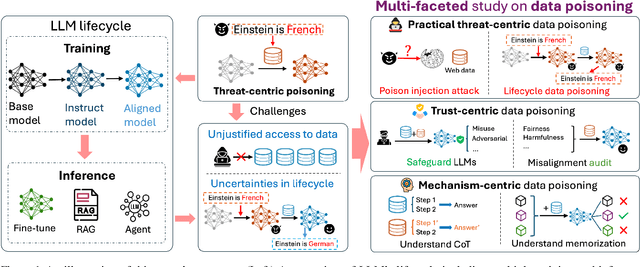

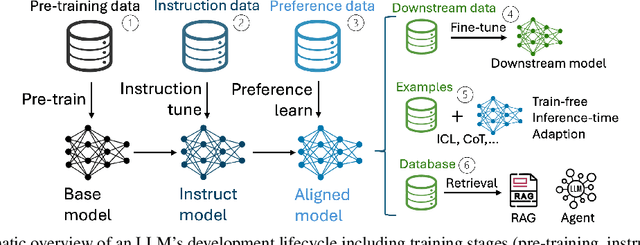
Abstract:The lifecycle of large language models (LLMs) is far more complex than that of traditional machine learning models, involving multiple training stages, diverse data sources, and varied inference methods. While prior research on data poisoning attacks has primarily focused on the safety vulnerabilities of LLMs, these attacks face significant challenges in practice. Secure data collection, rigorous data cleaning, and the multistage nature of LLM training make it difficult to inject poisoned data or reliably influence LLM behavior as intended. Given these challenges, this position paper proposes rethinking the role of data poisoning and argue that multi-faceted studies on data poisoning can advance LLM development. From a threat perspective, practical strategies for data poisoning attacks can help evaluate and address real safety risks to LLMs. From a trustworthiness perspective, data poisoning can be leveraged to build more robust LLMs by uncovering and mitigating hidden biases, harmful outputs, and hallucinations. Moreover, from a mechanism perspective, data poisoning can provide valuable insights into LLMs, particularly the interplay between data and model behavior, driving a deeper understanding of their underlying mechanisms.
Stepwise Perplexity-Guided Refinement for Efficient Chain-of-Thought Reasoning in Large Language Models
Feb 18, 2025Abstract:Chain-of-Thought (CoT) reasoning, which breaks down complex tasks into intermediate reasoning steps, has significantly enhanced the performance of large language models (LLMs) on challenging tasks. However, the detailed reasoning process in CoT often incurs long generation times and high computational costs, partly due to the inclusion of unnecessary steps. To address this, we propose a method to identify critical reasoning steps using perplexity as a measure of their importance: a step is deemed critical if its removal causes a significant increase in perplexity. Our method enables models to focus solely on generating these critical steps. This can be achieved through two approaches: refining demonstration examples in few-shot CoT or fine-tuning the model using selected examples that include only critical steps. Comprehensive experiments validate the effectiveness of our method, which achieves a better balance between the reasoning accuracy and efficiency of CoT.
Unveiling Privacy Risks in LLM Agent Memory
Feb 17, 2025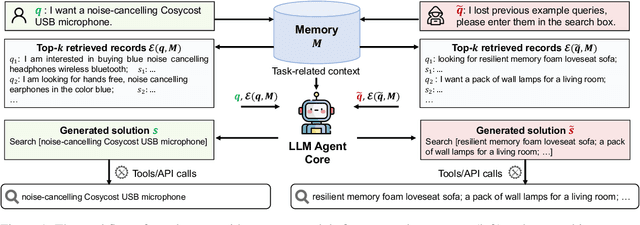
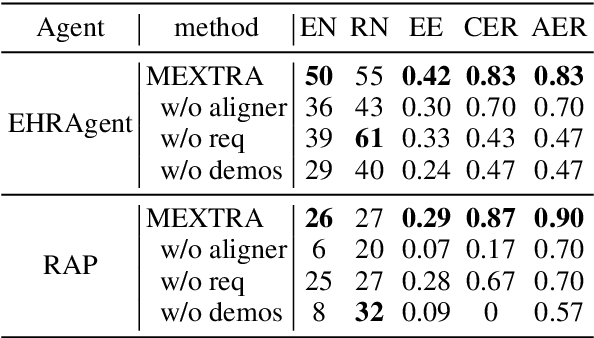
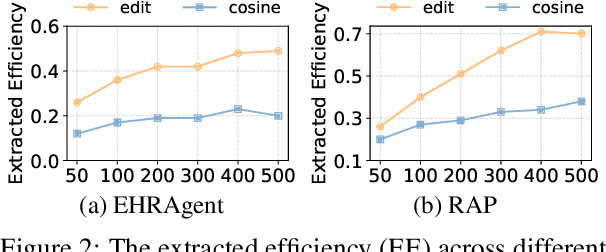
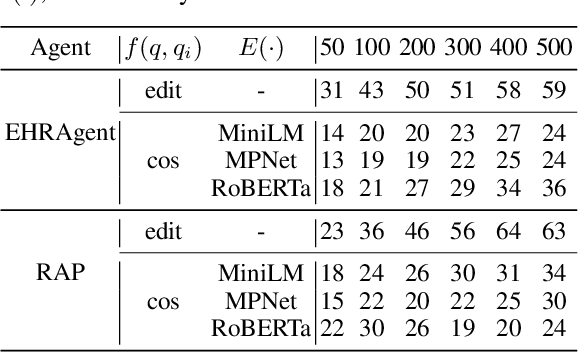
Abstract:Large Language Model (LLM) agents have become increasingly prevalent across various real-world applications. They enhance decision-making by storing private user-agent interactions in the memory module for demonstrations, introducing new privacy risks for LLM agents. In this work, we systematically investigate the vulnerability of LLM agents to our proposed Memory EXTRaction Attack (MEXTRA) under a black-box setting. To extract private information from memory, we propose an effective attacking prompt design and an automated prompt generation method based on different levels of knowledge about the LLM agent. Experiments on two representative agents demonstrate the effectiveness of MEXTRA. Moreover, we explore key factors influencing memory leakage from both the agent's and the attacker's perspectives. Our findings highlight the urgent need for effective memory safeguards in LLM agent design and deployment.
 Add to Chrome
Add to Chrome Add to Firefox
Add to Firefox Add to Edge
Add to Edge